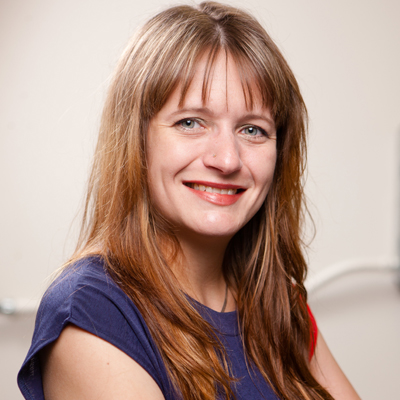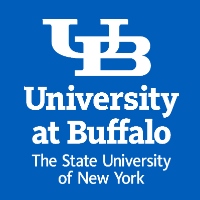Discovering new materials and chemical processes through theoretical and computational chemistry
What comes to mind when you think of a chemist? Probably beakers, volumetric flasks, bunsen burners, and pH meters. However, in the world of quantum chemistry, which is sometimes called computational chemistry or "virtual reality chemistry," chemists use computer simulations. Rather than watching chemical reactions in a sterile environment, computational chemistry is a desk job where chemical reactions and chemical species are analyzed, data is collected, and scientists are able to calculate and visualize molecular orbitals all from a computer desktop. This approach is advantageous because it ultimately results in general rules which can be employed by experimental groups to synthesize and design solids and molecules with desired properties for specific applications.
Dr. Eva Zurek, a quantum chemist at the University at Buffalo SUNY, conducts computer simulations, carried out with programs, which approximately solve the quantum mechanical Schroedinger equation. State-of-the-art computer facilities are used to: predict new materials for specific applications, uncover the relationship between structure, bonding and properties, reveal why a certain chemical species behaves the way it does, gain a more in-depth knowledge of a chemical system than is possible with experimentation, and help experimentalists interpret their results. Dr. Zurek's efforts decrease the time and effort required for experimentalists to develop new advanced materials and chemical processes. She is able to pave the foundation for experimentalists doing basic research to build upon her data to create wide ranging applications that will impact all of society.
Currently, Dr. Zurek and her team are using theory, modeling and simulation to:
-
Predict materials that could be superconductors, that is those through which electricity can pass without resistance. Replacing copper wires with superconductors would have a tremendous impact on our electric power infrastructure. Unfortunately, the materials which scientists know of today become superconducting only at very low temperatures: the highest reached so far is -220 F. Scientists have long dreamt of a solid or liquid which remains superconducting at room temperature. Dr. Zurek's group predicts the structures of materials which could be superconducting at high temperatures.
-
Understand the chemical species and reaction mechanisms involved in making plastics. There is a multi-billion dollar industry centered around such processes, but surprisingly little is known about the fundamental chemistry. Currently, Dr. Zurek focuses on MAO (methylaluminoxane), one of the most important chemicals in this process in industrial applications. The results of this work are expected to provide knowledge that could lead to a decrease in the cost of plastics production, and design chemicals to make plastics with superior characteristics.
-
Study how organic molecules self-assemble when deposited on metal surfaces. This research could ultimately lead towards the rational design of two-dimensional organic electronics (for example plastic-like flexible TV displays), as well as organic light-emitting diodes for smart-phones and TV screens, and ferroelectrics.
-
Investigate the behavior of boron carbide across a wide pressure range. This superhard material can potentially be used in tank armor, bulletproof vests, as an absorbent for neutron radiation in nuclear power plants, and in the capsule that houses hydrogen in inertial confinement fusion experiments.
-
Investigate the effect of pressure on chemistry. The pressure variable can be employed to: synthesize new materials with unique properties (one famous example is diamond which forms within the earth, but it is less stable than graphite at atmospheric conditions); access new properties and states of matter (e.g., at least 23 elements become superconducting under pressure); advance understanding in geosciences and planetary science (the pressure at the earth's core is 3.5 million times larger than on the earth's surface, and the pressure within giant planets such as Jupiter is much higher). Dr. Zurek is helping to uncover just how different chemistry is under pressure.
-
Develop computer algorithms that can be employed to predict the structure of a chemical system given only its chemical composition. Zurek's group has written XtalOpt, http://xtalopt.openmolecules.net/wiki/index.fcgi/, an open-source evolutionary algorithm that can be combined with quantum mechanical calculations to determine the most stable geometries or crystal structures of solids. This development opens the door towards the computational prediction of advanced materials including: superconductors, batteries, hydrogen storage media, high-energy density and superhard materials, sensors, and memories, to name a few.
-
Enhance existing cyberinfrastructure by contributing towards open-source software programs (such as the molecular editor Avogadro, http://avogadro.cc/wiki/Main_Page) that can be used to analyze, visualize, and manipulate chemical structures.
-
Develop novel educational materials to train students from high school to the graduate level in the computational modelling of chemical systems.
Dr. Zurek's approach is in-line with the spirit of the Materials Genome Initiative for Global Competitiveness put out by the White House in 2012 (http://www.whitehouse.gov/mgi). Historically, it has taken about 10-20 years from the initial discovery of a material to its first use in real-world applications. By combining computational modeling and simulation, of the type carried out in Dr. Zurek's lab, with digital data and experimentation, new and better materials can be developed at a fraction of the time it has taken in the normal paradigm. Dr. Zurek's research enables real-world innovation that will impact the environment and society by paving the way for designing new compounds and materials, and chemical processes.
Bio
Eva Zurek performed her Doctoral work at the Max Planck Institute for Solid State Research in Stuttgart, Germany. Her postdoctoral research was carried out at Cornell University under the guidance of Prof. Roald Hoffmann (1981 Nobel Laureate in Chemistry). In August 2009, Eva began her current position as an assistant professor in the Department of Chemistry at the University at Buffalo, SUNY and was promoted to Associate Professor with tenure in August 2014.
Eva's research group studies the electronic structure, properties, and reactivity of a wide range of systems using the computational approaches of quantum chemistry, and band structure methods. Particular emphasis has been placed on the development of XtalOpt, an open-source evolutionary algorithm for crystal structure prediction. She has employed XtalOpt to predict the structures of hydrogen-rich solids with unique stoichiometries and novel bonding under pressure, because they have the potential to be superconducting at high temperatures. Other current interests include: the self-assembly of organic molecules on coinage metal surfaces, heterogeneous catalysts in olefin polymerization, OpenChemistry, as well as the electronic structure of solvated electrons, electrides and alkalides.
Eva received the prestigious 2013 Alfred P. Sloan Research Fellowship, the 2014 TMS Young Leaders Professional Development Award and the 2014 UB Exceptional Scholar, Young Invesigator Award.
Eva Zurek was born in Crakow, Poland, in 1976. After a brief stay in Austria her family immigrated to Canada when she was 5. She obtained an MSc in theoretical chemistry from the University of Calgary in 2002, and completed her PhD in 2006 at the Max Planck Institute for Solid State Research in Stuttgart, Germany. She was a postdoctoral fellow at Cornell University with Roald Hoffmann, and is currently an associate professor at SUNY Buffalo.
Website: http://www.acsu.buffalo.edu/~ezurek/index.html
Software Developments: All written under open-source licenses, such as GPL (Gnu Public License) or BSD (Berkley Software Distribution).
1. XtalOpt: http://xtalopt.openmolecules.net/wiki/index.fcgi/
2. XtalComp: http://xtalopt.openmolecules.net/xtalcomp/xtalcomp.html
3. Avogadro: http://avogadro.cc/wiki/Main_Page
In the News
Hydrogen may be metalized by adding sodium, possibly resulting in a new superconducting metal.


